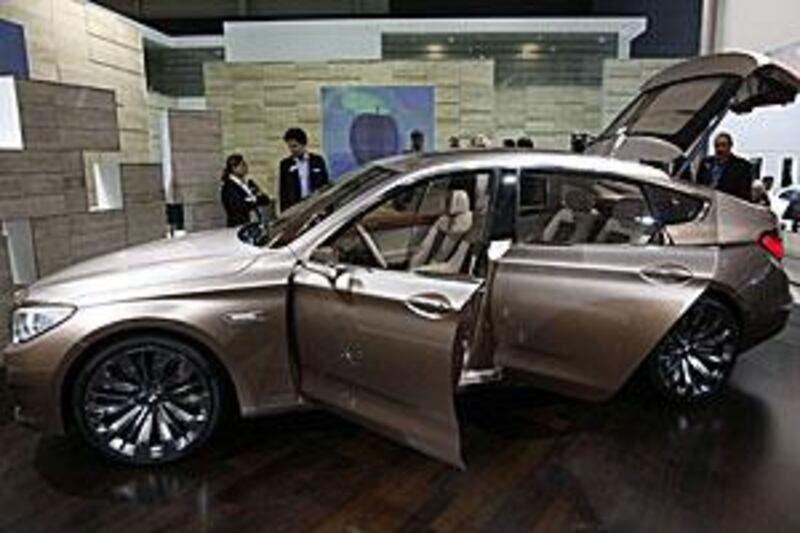To the critics, it's another example of BMW trying to convince people to buy into a market niche that doesn't exist. To BMW, the 5-Series Gran Turismo concept is something more fundamental. With departing design chief Chris Bangle using the word "sexy" no less than seven times to present the car in Munich, BMW insists that, besides its other benefits, it's also the most customer-centred car the company has ever done.
Officially a concept, the 5-Series Gran Turismo sits between the 5- and 7-Series in size and will actually hit the streets of Europe in the final months of 2009 bearing PAS (Progressive Activity Sedan) badges. While BMW calls it a revolution in delivering the kind of cabin comfort its buyers actually want, its sleek, sportier silhouette takes clear hints from the Rover Vitesse and offers something more practical than a saloon and less stodgy than an estate car.
It absorbs practical SUV solutions by offering full- or part-opening large rear hatch, it offers a higher seating position than the 7-Series and it provides abundant rear leg and head room Production versions will initially run six-cylinder and V8 petrol engines as well as six-cylinder turbo-diesels and, BMW confirms, the PAS is also likely to be available with all-wheel drive. An eight-speed automatic will be standard, though Europe is certain to also have a six-speed manual version available.
It will usher in a new era of BMW's Efficient Dynamics philosophy of safety and economy through agility and clever thinking, too. The PAS will almost certainly be the first car to receive BMW's new thermo- electric systems, which take wasted heat from the engine and exhaust and translate it into electrical power. But is it enough to find the PAS a place in a difficult modern world? BMW sincerely hopes so, because it knows it's taking a risk sending it out into the production world - especially in a recession.
"This is the most customer- centred car we had ever done," Bangle admitted. "What was really unusual is that we did not start with a preconceived idea of what it would be like. "We think this is the correct approach in the future for many things, because customers are moving away from wanting to be categorised and they want things to suit their lives instead. "We have an obligation in our core products to deliver what people want. If we don't, one day we will wake up and find all these expensive sports car and luxury cars and the new generation won't care unless they can get it on a PlayStation."
That's why this car took four years in design and planning, starting life even before BMW had a platform to sit it on. There are distinct similarities to the low-volume X6, which actually debuted as the Deep Blue concept in 1996 but had to wait for the current X5 platform before it could be mass produced last year. This car might be called a 5-Series Gran Turismo, but underneath, it's a slightly modified version of the new 7-Series.
Unlike traditional BMWs, the design team played trial-and- error with the Gran Turismo in ways BMW had never seen before. "We had so many mock-ups for the interior that I could not tell you how many there were," Bangle admitted. "We had a lot of prototypes, too - and a lot of them were photographed on the road - because we were trying to work out what was an acceptable position for the driver, what was an acceptable position for the passenger and what we didn't like.
"Even before that, we did a lot of full-size clay models. Couldn't tell you how many. At the Geneva show, four years ago, we were already up to our ears in it." The end result is a car that looks far better in the metal than it does in photographs, with full, rich-looking panels broken up with crisp and subtle lines and, for the first time in what seems like an eternity, creating a completely integrated profile look for a large BMW.
Penned by BMW's Christopher Weil, the concept takes advantage of frameless doors to give its roofline a coupe-like swoop and adds width to its rear end by cleverly using horizontal themes. While there are a lot of recognisable BMW family buttons and switches inside, the driver sits 60mm higher than in the 5-Series and the immense 3007mm wheelbase lends the cabin enormous legroom in every seat. BMW has taken that further though, by adding rear seats with electric legroom and backrest adjustment.
To add to the impression of space, interior designer Oliver Heilmer gave the car a panoramic glass roof to allow more light. While this is a breakthrough for BMW, glass roofs have been available on more humble cars, such as Peugeot's 308, for some time. There is also a lot of headroom and the luggage area is cleverly thought through. For example, you can open the small rear hatch which keeps the passenger compartment sealed to keep cold or hot air out, or you can put larger items in through the full hatchback. The rear seats also fold almost flat, giving up to 1650 litres of luggage capacity.
While a hybrid version is technically possible (actually, technically easy, given it shares its architecture with the X6 and 7-Series), insiders admit it's not a priority for the PAS.






